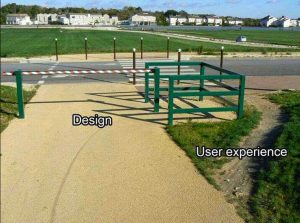You do this by optimizing your website for search engines. In this article I will describe step by step how you can do this all by yourself.

You want more visitors to your website (who doesn't?).
The only question is: How do I do that? Without spending even 1 cent on advertising.
You do this by optimizing your website for search engines. In this article I will describe step by step how you can do this all by yourself.
What is SEO?

SEO is short for Search Engine Optimization. The optimization for search engines of your website.
The goal of SEO is to get your website higher in search engines, such as Google.
In the article "What is SEO" I already went deeply into what SEO is, so I will leave that out here. I will immediately start with the steps for more visitors to your website!
Website SEO step 1: Do a Keyword Research

In my opinion you should start with keyword research. Always.
With a keyword research you will determine which keywords you want to be found on.
Only when you know which keywords you want to be found on can you determine what efforts you need to make to achieve that. For example, you will have to create content that is aimed at your keywords.
In a keyword research you look for the keywords that are relevant to your business and that you expect to convert well into sales or leads. After all, you don't get much of visitors to your site who don't buy anything.
In a keyword research you will also assess whether it is feasible to obtain a top position in the search engines for your keywords.
You may want to be number one on the search term "blogger template", but as a starting self-employed person you will not be able to do that 1-2-3. The competition is too great for that search term.
It may all sound very complicated, but that is not so bad. There are a few things you need to know and there are tools you will need to conduct your keyword research.
In my article about keyword research you will learn how to do keyword research yourself like a real SEO pro.
Website SEO step 2: The Technique
The technique of your website is important and it is also good to deal with it. You can influence it yourself and it is often only a small effort to get things technically in order.
I will discuss the matters that you can tackle technically on SEO in sub-steps here.
Step 2A: Keep a Finger on The Pulse

Submit your website to Google Search Console. If Google finds technical errors on your website, you will see them in your Search Console.
Google shows whether pages give a 404 error (not found) and shows whether pages with duplicate content have been found.
Even if your website has been given a manual penalty for violating Google's webmaster guidelines, you will be able to find it in your Search Console.
I can advise you to have a look in Google Search Console at least once a week. If something is wrong then you are right there and hopefully you can limit the damage.
Step 2B: Create an XML sitemap
Google can find all your pages in your sitemap. By including a sitemap you can be sure that Google can find and index all your pages.
In your sitemap you can also prioritize pages and indicate when a page was last modified.
If you use WordPress, you can use a plugin to generate a sitemap.
With a plugins such as the RankMath SEO plugin you can activate the sitemap with the push of a button.
Step 2C: Create a Responsive Website

A website that is responsive gets priority in Google over sites that are not.
Moreover, you naturally serve your website visitors better with a responsive website.
Step 2D: Use HTTPS

Especially if you have a webshop or sell products through your website, HTTPS is an absolute must.
You will then see a green lock in the browser bar as a sign that the connection is secure. This way, there is no need to worry that private or payment details will be intercepted by third parties.
Step 2E: is your Site well Organized?
A nice clean HTML code is not a direct ranking signal for Google, but it does determine how your website looks in the browsers of your visitors. And satisfied users usually ensure a satisfied search engine.
To check your site for HTML errors, you can use the W3C Markup Validation Service.
It is not a disaster if your site contains a few errors, but it is important to fix the gross errors.
Step 2F: Does Your Site Load Quickly?
Another technical point that counts for your ranking is the loading time of your website.

You can influence the loading time of your website by choosing a good hosting provider. Cheap is expensive in that respect.
Providers that offer extremely cheap hosting can only do this by accommodating many sites on 1 server (environment). You then have to share the computing power and bandwidth with many other websites, which makes your own site slower.
If you use WordPress or Joomla, you can further improve the loading time of your website by means of cache plugins.
>>>> MUST READ: How to Use SEO to Drive High Quality Organic Traffic
To further improve the speed of your website, you can also use a CDN (Content Delivery Network). This is certainly recommended if you have a busy website.
Step 2G: Provide a Good Structure
By ensuring that the structure of your website is not too deep, you ensure that all "link juice" can reach the underlying pages properly.
Aim for a structure that is no deeper than 2 layers (a flat structure, which can be wide).
Under your homepage, for example, you hang a number of product categories under which your products will hang.
Website SEO step 3: On Page SEO factors
In addition to the technical SEO factors, you can also influence a number of On Page SEO factors. I will explain these in sub-steps here.
Step 3A: Use a Title Tag

The title tag you will use is determined by your keyword research. On the landing page that you have set up for the search term "blogger template", your title tag will be "Looking for blogger template with SEO?"
The title tag is used by Google in the search results. The text that you see in Google and is blue, that is the title tags of these web pages.
The title tag affects your google ranking because your title tag affects the click-through behavior of people.
If your title tag is inviting, people are more likely to click through to your site. A high Click Through Rate is good for your ranking.
Your title tag can be 512 pixels. If you ensure that your title tag does not become longer than 60 pixels, then you are always fine with the length.
Step 3B: Use a Meta Description

This text is also important because it influences people's click-through behavior. The optimal length for the meta description is 150 to 160 characters.
Step 3C: Internal Links
Links are important for your ranking. It is often thought that only the external links that point to your site are important, but that is not the case.
Internal links are also good for your ranking. They tell the search engines which pages within your domain are important.
Therefore, make sure that internal links are included to the pages with which you would like to rank well.
Conversely, you can also boost new content by linking to it from pages that already have a lot of authority in Google.
Step 3D: Use Breadcrumbs
You can also use breadcrumbs to create internal links. Especially if you have a webshop, the use of breadcrumbs is recommended.
Website SEO step 4: User Experience

A good user experience is indirectly an important ranking factor. Google sees it as a positive signal if people are on your website longer and visit multiple pages.
There are a number of other things you can do to improve the user experience. I will discuss these point by point here.
Step 4A: Social Share buttons

Make sure you make it as easy as possible for them to share your content by including Social Share buttons on your website.
Step 4B: Short and Readable URLs
Provide URLs that are short and that tell something about the content of your web page. So go from a URL such as https://techbytebox.blogspot.com/2020/09/guest-posting-for-seo.html and not for URLs such as https://techbytebox.blogspot.com/?page_id=15
It is advisable to include your keywords in your permalink.
Step 4C: Use numbers in Title Tag
Research has shown that the CTR of title tags containing a number is higher.
Odd numbers in particular work well for increasing CTR.
Step 4D: Use Click Magnets in Your Title Tag
Certain words elicit a click to your website from Google. Words that you can include in your title tag for this include:
- Proven
- Now
- Free
- New
Website SEO step 5: Copywriting

Your content is really super important. Your site may be technically in order, but without good content you can wait a long time for visitors.
With the keyword research you have determined which keywords you want to focus on. Then it is important to start writing content about these keywords.
On the basis of the content, the search engines determine what a page is about.
The interaction that your visitors have with your content is a signal for the search engines to assess the quality of your content.
If people quickly return to the search engine to continue searching for the same keyword, it is a sign to the search engines that they did not find what they were looking for on your website.
It is therefore important that you can answer the search intent of the searcher with your content.
It is also a good sign if people stay on your page for a long time. Here we will give you a number of copywriting techniques that you can apply to make your content SEO proof.
Step 5A: Use Headings

By making frequent use of headings you make your content scannable for your readers. If you can quickly find what you are looking for, you will not return to the search engine to continue searching.
The headings (such as H2, H3) also indicate the structure and important parts of your content for the search engines.
Step 5B: Use Images

Especially if you can make things clear with images, these should not be missing.
In addition to images, you can also use video to clarify matters. You can simply embed a YouTube video on your web page or create your own video material.
Step 5C: Use White Spaces
To keep your content easy to read, you can use a lot of white spaces between sentences and paragraphs.
This also makes your content easier to scan for the reader.
Step 5D: Updating Old Content
People don't like to read something that is outdated or out of date.
Therefore, go through your old content at least once a year to see if everything is still up to date and still correct.
By adjusting your content, you signal to the search engines that your content is kept up to date and that it is okay to send people to it.
Step 5E: Remove Old and Bad Content
Many sites contain old pages with outdated content that generate little or no visitors.
This content is outdated or the content is simply badly written. It is a good idea to remove content from your website that does not generate visitors and to forward (redirect) the old URLs to new URLs.
This way, your internal link juice will only go to the content that matters. This way you boost the content of the pages that are important.
Step 5F: Write SEO Texts Like a Professional
Want to learn more about writing SEO content?
Then read our special "The New Guide For Getting Rankings And Hordes Of High-Quality Traffic With SEO".
Website SEO step 6: Link building
The last step is link building. Backlinks are still the most important ranking factor for Google, but in my opinion they should only be the last step you take with optimizing your website.
I think you are sending the wrong signal to the search engines if other sites start linking to you if there is no content on it yet.
This is a sign of links that have not been obtained naturally. It would make more sense if people would link to your website if it contains (interesting) content.
>>>> MUST READ: How to improve the loading time of your WordPress site
You can of course do link building in addition to other optimization points such as improving the loading time of your website.
Step 6A: Provide Support Tools

The use of a number of SEO tools is therefore highly recommended.
You save valuable time and they give you an advantage over your competition.
Step 6B: Make a Link Bait

Of course you prefer that people will link to your site on their own initiative, without having to ask for it.
You can achieve this by using a link bait ("link bait").
Conclusion on Website SEO

As you can see from this article, getting many websites visitors is hard, but above all smart work.
I hope the information in this article gives you the basic knowledge to get started with SEO yourself.
If you have any questions, feel free to ask them below in the comments.





COMMENTS